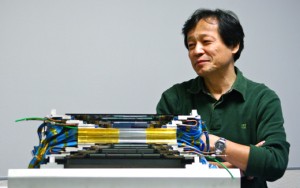The Linear Collider Collaboration (LCC) was established in February 2013, and the organisation of the physics and detector part started to form over the following several months with regional representatives, concept group representatives, and working groups. One important ingredient for the organisation was the physics and detector advisory panel (PDAP) that advises the Associate Director for Physics and Detectors (currently me) in executing his or her mandate. The charge for the PDAP that has been approved by the Linear Collider Board states that ‘the PDAP monitors the physics and detector activities of the ILC and its synergies with CLIC’, and that it ‘makes recommendations such that appropriate progresses are made toward realization of linear collider detectors and collaborations.’ Its function is similar to that of the International Detector Advisory Group (IDAG) that existed before the time of the LCC.
Since the function of the PDAP was considered to be important in guiding the development of the physics and detector efforts, its chair was selected and appointed at an early stage. Because of his wisdom in issues regarding physics and detector activities in general, his wide and deep knowledge on the linear colliders as well as his long-time commitment to our efforts, I was very happy to have Paul Grannis on board as the PDAP chair. He was also a member of the IDAG in the past.
The composition of the PDAP and that start of its real activities took longer and were more difficult. One problem is that the current organisation does not have a clear benchmark goal such as the detailed baseline report (namely, Volume 4 of the ILC TDR), which guided the reviewing activities of the IDAG during the period preceding the LCC. The natural next benchmark after the detailed baseline report would be a real engineering design report; such a report, however, would be produced by a real collaboration after a linear collider laboratory is formed or at least known to be formed in the near future. We are unfortunately not at such a stage yet. Intense discussions took place in many physics and detector executive board meetings on how to define the concrete charge for the PDAP in this uncertain time. There also was a strong point expressed that heavy reviews conducted by the PDAP at this time of low resources would be counter productive. It is only recently that we came to an agreement on the nature of the PDAP and its reviews.
In the end, we decided to form a ‘lightweight’ review panel that does not require a large amount of work for the reviews, neither for those who review nor those who are being reviewed, but still can extract recommendations useful for the physics and detector activities. Thus, two additional members were selected: Sandro Palestini from Europe and Junji Haba from Asia. Sandro is knowledgeable about CERN-related issues and also used to be a member of the IDAG. Junji is an internationally known expert on detector R&D, and he was a member of a committee that reviewed the ILC detector R&D efforts in the past. With Paul being from Americas, they are well balanced regionally and in expertise.
At the linear collider workshop held at Whistler, Canada, the PDAP had its first review. The total allotted time was two hours and within its limited time, presentations on status and plans for the ILC detector concept groups (ILD and SiD) as well as on synergy of physics and detector efforts of ILC and CLIC were made, followed by discussions. Then there was a session where representatives of major detector R&D groups were invited to discuss possible technical review to be conducted in the future. The report is now public and posted here. I encourage you to take a look at the report for the content, but here I quote one sentence in the preamble which describes the nature of the review well: “The reviews offered an opportunity to take a snapshot of the current status and to look toward future activities when a decision to proceed with linear collider construction is made.”





Recent Comments